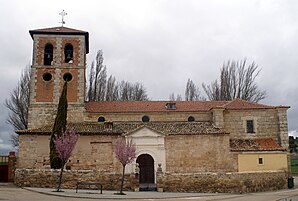Corcos del Valle
| Corcos del Valle municipality | ||
|---|---|---|
 Corcos del Valle - Santa María la Mayor Church
|
||
| coat of arms | Map of Spain | |

|
|
|
| Basic data | ||
| Autonomous Community : |
|
|
| Province : | Valladolid | |
| Comarca : | Montes Torozos | |
| Coordinates | 41 ° 49 ′ N , 4 ° 42 ′ W | |
| Height : | 790 msnm | |
| Area : | 42.59 km² | |
| Residents : | 201 (Jan. 1, 2019) | |
| Population density : | 4.72 inhabitants / km² | |
| Postal code : | 47280 | |
| Municipality number ( INE ): | 47055 | |
| administration | ||
| Website : | Corcos del Valle | |
Corcos del Valle or just Corcos is a place in northern Spain and a municipality ( municipio ) with 201 inhabitants (as of January 1, 2019) in the east of the province of Valladolid in the autonomous community of Castile-León .
location
The place Corcos del Valle is located on the Castilian plateau at an altitude of about 790 m above sea level. d. M. The provincial capital Valladolid is only about 21 km (driving distance) south; Palencia , the capital of the neighboring province, is a good 31 km to the northeast. The climate in winter is quite cold, but in summer it is warm to hot; the sparse rainfall (approx. 435 mm / year) falls throughout the year.
Population development
| year | 1857 | 1900 | 1950 | 2000 | 2016 |
| Residents | 1,071 | 927 | 933 | 270 | 214 |
The population decline in the second half of the 20th century is mainly due to the mechanization of agriculture and the resulting loss of jobs.
economy
The farming on the fertile clay and loess soils and the keeping of small cattle (especially chickens) formed the livelihood of the self-sufficient population of the region for centuries ; Mules and donkeys were kept as draft and pack animals. Surpluses could be sold in the Valladolid markets. Since the Middle Ages, handicrafts, retail trade and service companies of all kinds have developed.
history
In pre-Roman times the region belonged to the settlement area of the Celtic tribe of the Vaccaeans ; Later came the Romans and Visigoths and in the 8th century the area was overrun by the Moors - however, all four cultures have left little archaeologically usable traces in the formerly possibly forested area. Already in the 9th century Asturian-Leonese army conquered the areas north of the Duero back ( reconquista ) . At the end of the 10th century, the Moorish military leader Almansor temporarily wiped out the Christian successes, but in the 11th century the Kingdom of León expanded its territory again to the Duero border. The region was repopulated ( repoblación ) . After previous attempts, León finally united with the Kingdom of Castile in 1230 , but disputes occurred again and again in the period that followed. The place experienced its heyday in the late Middle Ages and in the early modern period.
Attractions
- The construction of the three-aisled Iglesia de Santa María la Mayor , mostly made of precisely hewn natural stone , began in the first quarter of the 16th century. The numerous round windows in the upper part of the central nave and on the tower are remarkable . The three naves have stucco vaults on a wooden substructure. The main altar, designed in a strict Renaissance style , dates from 1656; further altars decorate the aisle walls.
- Surroundings
- The Castillo de Aguilarejo is located near the Canal de Castilla in the southeast of the municipality. It is a building with a castle chapel built in the 19th century in a mix of neo-Romanesque and neo-Gothic elements ; it is privately owned.
- The church of the Cistercian monastery of Santa María de Palazuelos , which was partly demolished in the 19th century and partly used as a barn, was built in the 13th century, but still in Romanesque style, and is only about 1.5 km further southwest near the Río Pisuerga .
Web links
Individual evidence
- ↑ Cifras oficiales de población resultantes de la revisión del Padrón municipal a 1 de enero . Population statistics from the Instituto Nacional de Estadística (population update).
- ↑ Corcos del Valle - Map with altitude information
- ↑ Corcos del Valle - climate tables
- ^ Corcos del Valle - population development
- ^ Corcos del Valle - Santa María la Mayor Church
- ^ Corcos del Valle - Monastery of Santa María de Palazuelos

